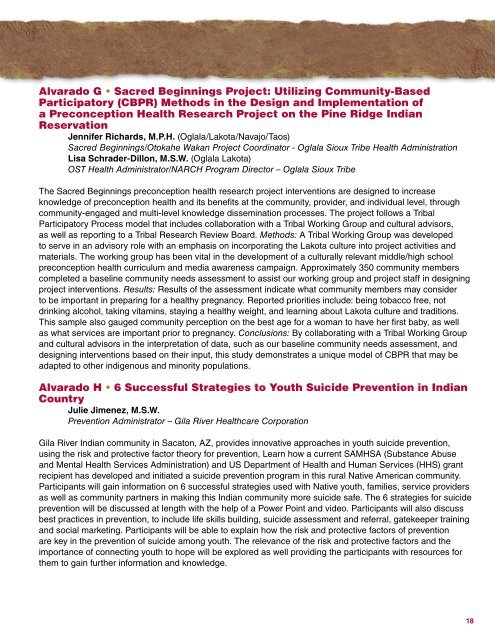10th Native Women & Men's Wellness .pdf - American Indian Institute
10th Native Women & Men's Wellness .pdf - American Indian Institute
10th Native Women & Men's Wellness .pdf - American Indian Institute
You also want an ePaper? Increase the reach of your titles
YUMPU automatically turns print PDFs into web optimized ePapers that Google loves.
Alvarado G • Sacred Beginnings Project: Utilizing Community-Based<br />
Participatory (CBPR) Methods in the Design and Implementation of<br />
a Preconception Health Research Project on the Pine Ridge <strong>Indian</strong><br />
Reservation<br />
Jennifer Richards, M.P.H. (Oglala/Lakota/Navajo/Taos)<br />
Sacred Beginnings/Otokahe Wakan Project Coordinator - Oglala Sioux Tribe Health Administration<br />
Lisa Schrader-Dillon, M.S.W. (Oglala Lakota)<br />
OST Health Administrator/NARCH Program Director – Oglala Sioux Tribe<br />
The Sacred Beginnings preconception health research project interventions are designed to increase<br />
knowledge of preconception health and its benefits at the community, provider, and individual level, through<br />
community-engaged and multi-level knowledge dissemination processes. The project follows a Tribal<br />
Participatory Process model that includes collaboration with a Tribal Working Group and cultural advisors,<br />
as well as reporting to a Tribal Research Review Board. Methods: A Tribal Working Group was developed<br />
to serve in an advisory role with an emphasis on incorporating the Lakota culture into project activities and<br />
materials. The working group has been vital in the development of a culturally relevant middle/high school<br />
preconception health curriculum and media awareness campaign. Approximately 350 community members<br />
completed a baseline community needs assessment to assist our working group and project staff in designing<br />
project interventions. Results: Results of the assessment indicate what community members may consider<br />
to be important in preparing for a healthy pregnancy. Reported priorities include: being tobacco free, not<br />
drinking alcohol, taking vitamins, staying a healthy weight, and learning about Lakota culture and traditions.<br />
This sample also gauged community perception on the best age for a woman to have her first baby, as well<br />
as what services are important prior to pregnancy. Conclusions: By collaborating with a Tribal Working Group<br />
and cultural advisors in the interpretation of data, such as our baseline community needs assessment, and<br />
designing interventions based on their input, this study demonstrates a unique model of CBPR that may be<br />
adapted to other indigenous and minority populations.<br />
Alvarado H • 6 Successful Strategies to Youth Suicide Prevention in <strong>Indian</strong><br />
Country<br />
Julie Jimenez, M.S.W.<br />
Prevention Administrator – Gila River Healthcare Corporation<br />
Gila River <strong>Indian</strong> community in Sacaton, AZ, provides innovative approaches in youth suicide prevention,<br />
using the risk and protective factor theory for prevention, Learn how a current SAMHSA (Substance Abuse<br />
and Mental Health Services Administration) and US Department of Health and Human Services (HHS) grant<br />
recipient has developed and initiated a suicide prevention program in this rural <strong>Native</strong> <strong>American</strong> community.<br />
Participants will gain information on 6 successful strategies used with <strong>Native</strong> youth, families, service providers<br />
as well as community partners in making this <strong>Indian</strong> community more suicide safe. The 6 strategies for suicide<br />
prevention will be discussed at length with the help of a Power Point and video. Participants will also discuss<br />
best practices in prevention, to include life skills building, suicide assessment and referral, gatekeeper training<br />
and social marketing. Participants will be able to explain how the risk and protective factors of prevention<br />
are key in the prevention of suicide among youth. The relevance of the risk and protective factors and the<br />
importance of connecting youth to hope will be explored as well providing the participants with resources for<br />
them to gain further information and knowledge.<br />
18


